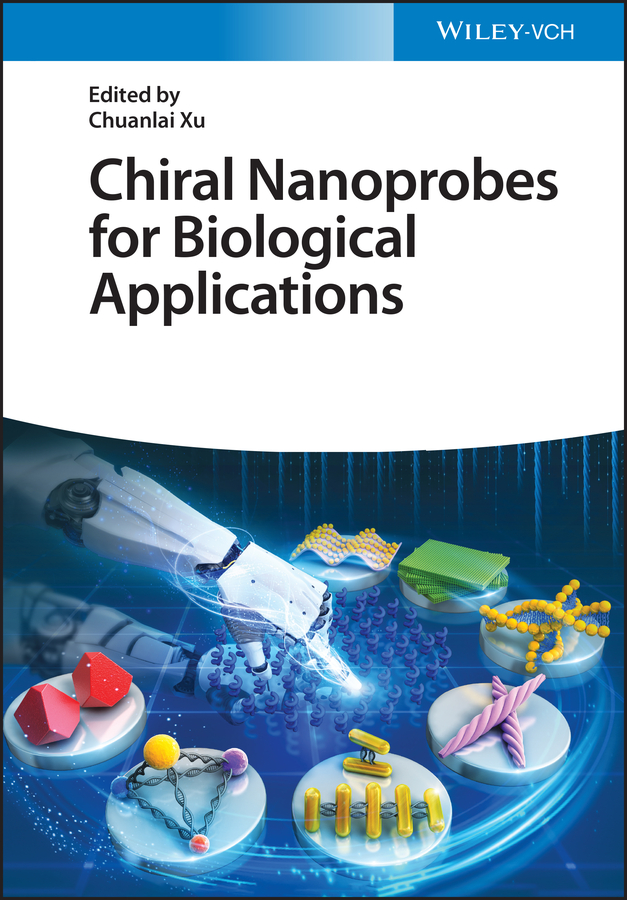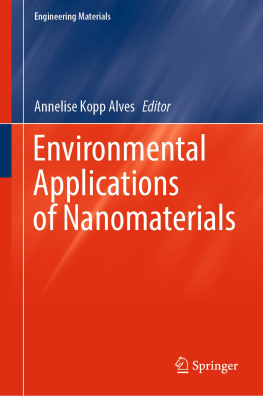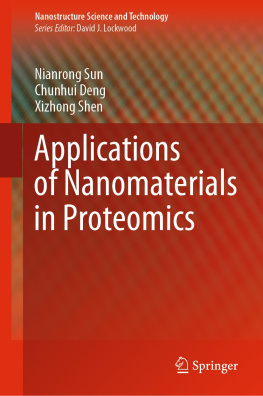
Table of Contents
List of Illustrations
- Chapter 1
- Chapter 2
- Chapter 3
- Chapter 4
- Chapter 5
- Chapter 6
Guide
Pages
Chiral Nanoprobes for Biological Applications
Edited by Chuanlai Xu

Editor
Prof. Chuanlai Xu
Jiangnan University
Food Science and Technology
1800 Lihu Da Road
Binhu District
214122 Wuxi
China
Cover Image: Chuanlai Xu
All books published by WILEYVCH are carefully produced. Nevertheless, authors, editors, and publisher do not warrant the information contained in these books, including this book, to be free of errors. Readers are advised to keep in mind that statements, data, illustrations, procedural details or other items may inadvertently be inaccurate.
Library of Congress Card No.: applied for
British Library CataloguinginPublication Data
A catalogue record for this book is available from the British Library.
Bibliographic information published by the Deutsche Nationalbibliothek
The Deutsche Nationalbibliothek lists this publication in the Deutsche Nationalbibliografie; detailed bibliographic data are available on the Internet at .
2022 WILEYVCH GmbH, Boschstr. 12, 69469 Weinheim, Germany
All rights reserved (including those of translation into other languages). No part of this book may be reproduced in any form by photoprinting, microfilm, or any other means nor transmitted or translated into a machine language without written permission from the publishers. Registered names, trademarks, etc. used in this book, even when not specifically marked as such, are not to be considered unprotected by law.
Print ISBN:9783527349425
ePDF ISBN:9783527833580
ePub ISBN:9783527833597
oBook ISBN:9783527833603
Preface
Chirality has always been one of the core research topics in multidisciplinary fields including materials science, chemistry, biology, physics, and so on. Of particular interest, recent advances in chiral nanomaterials represent one of the most dynamic areas and have emerged as a new growth point of nanoscience. Recent breakthroughs in chiral fabrication have led to the study of many interesting properties of chiral nanocrystals, and some have demonstrated realistic application potentials that may address key challenges at the heart of nanoscience. Nevertheless, only few chiralityrelated books have been published in recent years, most of which essentially focus on the introduction of different types of chiral materials, chiral nanophotonics and spintronics, and chiral separation techniques. However, the available books usually ignore or barely focus on introduction of chiral nanomaterials in biological applications, which is attracting increasing theoretical and applicative interests.
These reasons made us to realize that there is a need for a book that is capable of:
- (i) presenting the techniques and strategies in a clear and concise manner to understand chiral fabrications, chiroptical mechanisms, structure manipulation, and chiroptical enhancement;
- (ii) illustrating biological applications based on intense chiroptical signals, including chiralencoded recognition, bioanalysis, photochemical effects, and biocatalysts; and
- (iii) encouraging the researchers to the forefront of developments in chiral nanoscience, such as advanced chiralrelated multidisciplinary techniques for innovative fabrication methods, chiralrelated optical and physicochemical properties, futuristic visions of the lightmatter interaction.
It is timely and necessary to write a comprehensive book to introduce the stateoftheart advancements in strong chiroptical nanomaterials, their biological applications and to discuss their future avenues of research. To address such emerging advances, we present the book Chiral Nanoprobes for Biological Applications. In this book, we have attempted to provide developments in chiral nanoscience, with special emphasis on the milestones achieved in research on key chiral nanoprobes in the recent past fiveyears, focused on biological applications, and provided some specific future perspectives in the field.
Being actively involved in chiral nanoscience and having published more than 100 research articles and reviews, we have included six distinct chapters in the book. gives an introduction of chiral nanomaterials from their biological counterparts, chiral mechanism and theory. The origin of chiral materials brings new insights into understanding homochirality on Earth. The fundamental concepts about the nature of chirality is divided into four types the inorganic core, chiral ligands, chiral patterns, and electronic structures. The general principles, modeling, and methodology characteristics for computational studies of chirality have been presented for better understanding of nanoscale chirality.
introduce the fabrication technologies and strategies for fabricating individual chiral nanomaterials and chiral assembled nanostructures, with a focus on tailoring and enhancing chiroptical effects. Major efforts have been made to realize highpurity chiral nanomaterials consisting of ligand molecule moieties, semiconductors, metals, and other materials. Individual nanoparticles and their superstructures can display intensive chiroptical and chiralcoupled physicochemical or electrochemical secondary properties, as well as unique and useful functions. Strategies for chiral amplification including enantiopure nanocrystal synthesis, and highly spontaneous symmetry breaking or wellcontrolled chiral geometrical assemblies (pyramidal, helical, etc.), as well as highorder enantiomeric superstructures.
illustrates the fundamental concepts and the characteristic approaches related to chiral nanomaterials for biocatalysis. Chiral nanomaterials demonstrated as promising biomimetic catalysts afford facile preparation, tunability of catalytic activity, and high stability. Chiral molecules or chiral polymers are considered effective chiral selectors of nanocatalysts for asymmetric biocatalysis.
Finally, we would like to summarize future trends and perspectives in chiral nanoscience. Robust artificial chiral fabrication techniques and multilevel hierarchical chirality control for precise tuning of polarization rotation in inorganic nanostructures will enable development of multidisciplinary chiral nanoscience in future. (i) Synthesizing or assembling complex nanostructures with ultrastrong chiroptical effects is an intrinsic challenge for all nanoarchitectures without exception, where. extreme control on enantiomeric purity to achieve high anisotropy factors is in great demand. (ii) It is crucial to integrate multiple techniques from various fields such as supramolecular chemistry, inorganic synthesis, selfassemblies, and related largescale construction (lithography, selective deposition, glancing angle evaporation, etc.) for homochiral fabrication in large quantity with a higher degree of structural chirality. (iii) The theoretical simulation can be used to uncover the chiral growth dynamics for predicting potential routes for chiral induction and amplification, which may include how the ngstrm and nano scale chirality being induced and transferred to the scales of meso, micro, and macro inorganic structures? Through theoretical simulation of growth dynamics, the facile design and finetuning of chiral nanostructures with predesigned biological functions will be available. (iv) Chiralityrelated physicochemical properties may lead to a wide range of potential biological applications. There will be great opportunities to elucidate nanoscale chirality interactions with biological systems, such as chirality coupled biological processes and their evolution, chiral cascaded bioactivity levels, even for modulation of metabolic and immune processes. (v) The high degree of manipulating chiralrelated spins, electrons, and photons is promising for realtime biological applications, such as lightresponsive molecular machines or excellent candidates for better therapeutics or biomimetic nanocatalysts.
Next page






